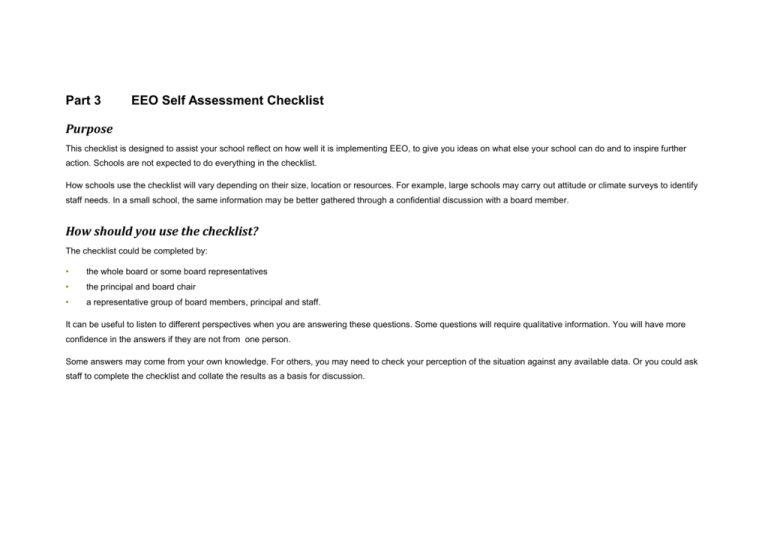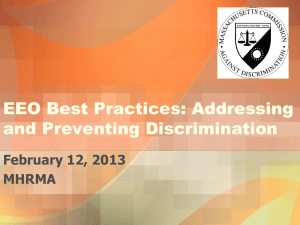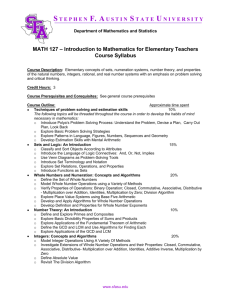EEO Self Assessment Checklist
advertisement

Part 3 EEO Self Assessment Checklist Purpose This checklist is designed to assist your school reflect on how well it is implementing EEO, to give you ideas on what else your school can do and to inspire further action. Schools are not expected to do everything in the checklist. How schools use the checklist will vary depending on their size, location or resources. For example, large schools may carry out attitude or climate surveys to identify staff needs. In a small school, the same information may be better gathered through a confidential discussion with a board member. How should you use the checklist? The checklist could be completed by: • the whole board or some board representatives • the principal and board chair • a representative group of board members, principal and staff. It can be useful to listen to different perspectives when you are answering these questions. Some questions will require qualitative information. You will have more confidence in the answers if they are not from one person. Some answers may come from your own knowledge. For others, you may need to check your perception of the situation against any available data. Or you could ask staff to complete the checklist and collate the results as a basis for discussion. Suggestions for completing the checklist When you answer the questions remember to think of all groups of staff. When you are about to tick something as not relevant, do a double check to ensure it is not just something that hasn’t been tried before in your school. Be honest. The information is for your school’s use only. A Commitment Yes Explicit commitment 1. Does your school have a written statement of commitment to EEO e.g. as an EEO policy or included within your school’s statement of values? 2. Are steps taken to ensure that staff are aware of the school’s commitment to/policy on EEO? 3. Has your school identified and publicised the benefits for your school in implementing EEO? 4. Do you ensure that any new policies or procedures are checked against the school’s EEO policy? Partial or for some staff only Planned or being developed No Not relevant Don’t know Yes Responsibility for facilitating progress on diversity or EEO 5. Do you have a senior person in your school who champions or sponsors EEO issues? 6. Do you have a person or group responsible for facilitating progress on EEO? 7. Is EEO actively considered in your strategic planning process? EEO understanding and awareness 8. Do your board and senior staff have a good understanding of EEO and the implications for schools? 9. Do all staff generally have a good understanding of EEO and how it is applied in your school? Equipping people in management or supervisory roles to apply EEO principles in their everyday management 10. Have staff responsible for supervising or managing other staff been given support (e.g. training, guidelines, management forums) on implementing EEO as part of their everyday management? EEO in decision-making 11. Is the impact on diverse staff (e.g. Maori, Pasifika, people with family responsibilities, people who work part-time) actively considered as part of any people management decisions made by your school? 12. Does your school actively seek and consider the views of diverse staff when making decisions that affect staff? Partial or for some staff only Planned or being developed No Not relevant Don’t know Yes B Integration of EEO into policies and processes Job design 13. Does your school actively consider and plan for having appropriate staff to work effectively with the diverse students and families in your community? 14. Would your school consider swapping responsibilities amongst staff in order to employ teachers who have particular needs (e.g. physical disability, religious requirements)? Recruitment 15. Does your school provide applicants with a copy of your EEO or diversity policy or statement? 16. Does your school use recruitment techniques deliberately designed to reach a diverse audience (e.g. Maori media, community networks)? 17. Do the recruitment materials used by your school (e.g. advertisements, brochures or website) use photographs, images or messages that demonstrate that your school is open to applications from people from diverse backgrounds? 18. Does your school monitor the range of applications received to check that you are attracting diverse applicants? 19. Does your school actively encourage people in your community from groups who are currently under-represented in teaching (e.g. Maori, Pasifika), and who could be good teachers, to enrol in teacher training? Partial or for some staff only Planned or being developed No Not relevant Don’t know Yes Selection 20. Does your school include the knowledge and ability to work with the diverse students and their families in your community as part of your selection criteria? 21. Does your school actively and fairly consider candidates from a range of ages? 22. Would your school actively and fairly consider candidates who have the skills to do the job and have a physical or sensory disability (e.g. blindness, wheelchair use)? 23. Does your school understand and offer the option of whanau interviews? 24. Have the people involved in the selection of staff been given training or guidance in how to avoid bias in the selection process? 25. Do you have an induction process for newly appointed teaching staff? 26. Do you have an induction process for newly appointed support staff? Work allocation 27. Are curriculum responsibilities deliberately spread across staff rather than assuming that Maori staff will take responsibility for all things Maori, or that male teachers will take responsibility for sport and outdoor education? 28. Is your school flexible in the way it allocates other responsibilities (e.g. swapping lunch time playground duties for other times to enable a staff member to breast feed her baby; swapping playground for library duties for a staff member in late pregnancy or with a physical disability)? 29. Does your school consult with teachers, rather than assume that students of a particular background will be placed in the class of the teacher from that same background? Partial or for some staff only Planned or being developed No Not relevant Don’t know Yes 30. Does your school have a way of regularly checking that individual staff are not being overloaded (e.g. staff providing pastoral care for Maori or Pasifika students)? 31. Does your school have a process for identifying and responding to early signs of staff ‘burnout’? Professional development 32. Does your school ensure that there are measures in place for all staff to have equitable access to professional development opportunities? 33. Does your school provide support (e.g. for childcare) to ensure that staff are able to take up professional development opportunities? 34. Does your school periodically (e.g. annually) analyse the professional development budget to ensure that it is being used fairly? 35. Does your school provide support for new teachers that takes account of their individual needs? 36. Is the support provided by more experienced teachers for new teachers recognised and valued? Career development 37. Does your school regularly check that work opportunities are being allocated fairly, and not being unconsciously influenced by factors such as gender or ethnicity? 38. Does your school provide teaching staff with advice and support regarding career development? 39. Does your school provide support staff with advice and support regarding career development? 40. Does your school provide mentoring or other similar support structures for staff? 41. Does your school actively ensure that diverse staff are aware of and able to gain the types of work experiences that will prepare them for promotion? Partial or for some staff only Planned or being developed No Not relevant Don’t know Performance management 42. Does your school implement a performance management system for teaching staff? 43. Does your school implement a performance management system for support staff? 44. Does your performance management system focus on what people achieve rather than on the hours people put in at the school? 45. Does your school value contributions to extra-curricular activities (e.g. running the kapa haka group)? 46. Have the people responsible for setting performance expectations and reviewing performance been trained in minimising the risk of bias? Yes Partial or for some staff only Planned or being developed No Not relevant Don’t know Yes Motivation and reward 47. Does your school actively consider and use a range of rewards or ways of valuing staff that works for the full range of staff you employ, rather than assuming that one way will work for all? Promotion 48. If your school has internal promotion opportunities, do staff have the opportunity to signal that they are interested in promotion? 49. Have the people who make decisions on promotion been given training or guidance on avoiding bias? C Culture that welcomes and values diverse staff Family-friendly/work-life balance Childcare 50. Does your school provide any practical support for preschool or after-school childcare (e.g. reservation of places in a local childcare facility, provision of a childcare centre)? Part-time or job-share 51. Is the option of working part-time available in your school for teaching staff? 52. Is the option of working part-time available in your school for support staff? 53. Are teaching staff who work part-time considered for promotion? 54. Are staff who work part-time or job-share included in staff meetings, social events etc? Partial or for some staff only Planned or being developed No Not relevant Don’t know 55. Have effective communication systems been established to ensure that staff working part-time or job-sharing are kept informed of key events or changes at the school (e.g. sports days, changes in timetable)? 56. Do you provide an effective induction programme for staff who work part-time? Parental leave 57. Can people going on or returning from parental leave work reduced hours? 58. Is contact actively maintained with staff on parental leave? 59. Are staff on parental leave offered relief teaching or special project work if it is available? Family leave 60. Does your school provide paid leave beyond the statutory requirement for staff to attend to family issues (e.g. bereavement, family illness)? Flexible hours 61. Can teaching staff take time during the day to attend to family matters (e.g. taking an elderly parent to the doctor, attending a child’s school activities)? 62. Can support staff take time during the day to attend to family matters? 63. Is the option of flexible hours actively considered for support staff? Practical arrangements to make it easier for staff to contribute 64. Is there a private, equipped room for use by staff who are breastfeeding or need to express breast milk? Prevention of harassment 65. Does your school have a sexual and racial harassment prevention policy that covers staff? (This may be included in a wider harassment prevention policy.) Yes Partial or for some staff only Planned or being developed No Not relevant Don’t know 66. Does your school have a general harassment and bullying prevention policy that covers staff? 67. Have current staff been made aware of your harassment prevention policies? 68. Are new staff made aware of your harassment prevention policies? 69. Does your school have people (internal or external) trained to provide staff who have been harassed with information and support? 70. Have your senior staff been given training on how to prevent harassment and respond appropriately if it does occur? Emphasising that staff are part of one team 71. Does your school actively work to ensure that there is not an “us” and “them” feeling between support staff and teaching staff? 72. Are support staff (e.g. teacher aides) comfortable joining teaching staff in the staff room? 73. Does your school actively recognise the contribution support staff make to students’ learning? Yes Partial or for some staff only Planned or being developed No Not relevant Don’t know Yes Support for diverse staff 74. Are Maori and Pasifika staff encouraged and supported to participate in Maori and Pasifika networks if they want to? 75. If your school staff is predominantly one gender, do you regularly check that staff of the other gender feel included, and are comfortable working with staff and the community? 76. Does your school welcome and support gay and lesbian staff? 77. Does your school take active steps to support teachers from overseas and introduce them to the local community? 78. Are staff welcomed and farewelled in a manner that is culturally appropriate for them? 79. Are all staff given the opportunity of professional development or support in cross-cultural awareness and communication? Social events 80. Are staff’s family members welcome to some of your school’s social events? 81. Are the partners of gay and lesbian staff members welcome to any social events to which other people’s partners or spouses are invited? 82. Do people who do not drink alcohol feel comfortable and safe attending your school’s social events? Partial or for some staff only Planned or being developed No Not relevant Don’t know Yes Physical environment 83. Can people who use wheelchairs access most of your school including the staff room, hall and toilets? 84. Can staff who suffer from asthma use alternatives to blackboards and chalk? 85. Do the decorations in your school reflect the diversity of cultures and ethnic backgrounds of your community? Communication 86. Are meetings run so that all staff feel comfortable sharing ideas or views? 87. Does your school ensure that meetings, e.g. syndicate meetings, are held at fixed times and for fixed periods so that staff can make appropriate childcare arrangements? 88. Does your school check that all communication materials do not include wording or images that may exclude or offend diverse staff or diverse groups in your community? D Identifying needs and monitoring progress Entrance and exit interviews 89. Does your school use an entrance interview (commonly held between six weeks and three months of starting date) to assess whether staff have any particular needs which if met would help them participate more fully and do their job more effectively? 90. Does your school use an exit interview process that includes examining EEO related issues? 91. Does your school use this information to improve the way it manages diverse staff? Partial or for some staff only Planned or being developed No Not relevant Don’t know Inclusion in climate surveys 92. Does your school have a process for identifying any issues or concerns that staff have about the school (e.g. climate or attitude surveys, confidential meeting with a board member)? 93. Does this process include questions that explore how well your school responds to the needs of diverse staff so they can contribute fully? 94. Does your school analyse the results of this process to see if there are any issues common to particular groups of staff (e.g. men and women, Maori, Pasifika, older staff)? Specific EEO information-gathering 95. Does your school carry out any EEO information-gathering processes (e.g. surveys, focus groups, consultation to assist with EEO planning)? 96. Has your school carried out an assessment of staff’s work and family needs? Monitoring the implementation of initiatives 97. Does your school have a process in place for monitoring the implementation of planned EEO or diversity initiatives? Yes Partial or for some staff only Planned or being developed No Not relevant Don’t know Yes EEO profile 98. Does your school collect and maintain reliable information on your staff so you can analyse who is in your school and what levels they are at in the school by gender? 99. Does your school collect and maintain reliable information on your staff so you can analyse who is in your school and at what levels they are at in the school by ethnicity, disability or age? Partial or for some staff only Planned or being developed No Not relevant Don’t know 100. Does your school regularly analyse this information and use it in your EEO or strategic planning process? Assessment: There are 100 questions If you have ticked yes for 70 or more, congratulations. Your school is obviously serious about EEO and making good progress in implementing it. If you have ticked yes for between 40 and 70, your school has made a good start, and has a good base to build on. If you have ticked yes for between 20 and 40, your school is still at the preliminary stages for implementing EEO. Analyse your answers to check what the next steps could be for your school. If you have ticked yes for less than 20, it is time to put EEO and diversity issues on your school’s agenda. Using the results of your EEO checklist How to check if your perception matches others in the school To ensure your checklist results are not one person’s perspective or experience of the school, verify them by: • talking informally with a range of other staff • inviting staff to comment either at team meetings or via e-mail • running focus groups with staff with an internal or external facilitator • designing and implementing a survey to canvass the issues. Analysing your results Check your overall tally Total your “yes” responses and check how your school rates on the assessment guide. Examine the pattern of your responses Are there particular areas where your school is strong or weak? These may be related to a particular issue e.g. recruitment, or to a particular group of staff e.g. staff working part-time or support staff. If so, what may be causing this? Are there lessons you can learn from the areas where your school is performing well that could be used to help address other issues? Communicating the results Who needs to know? At the minimum, it is useful for your board, principal and senior staff to know the results. You may also want to let all staff know the results and what you are going to do about them. What do they need to know? As well as your overall assessment, it is useful to give examples of the areas where you are doing well, and the areas where improvement is needed. Identifying priorities for action Your school will not be able to address all of the issues at once and you will need to prioritise see page 12. What needs to happen next? Use the information you have gathered to develop a planned approach to help your school capitalise on the benefits of EEO and diversity. This will require: • clear goals • relevant actions • specific timelines • measurable outcomes. Remember that this needs to be the school’s approach to EEO and diversity, not just the ideas of the person or people who completed this checklist. Make sure that you involve all the people needed to progress EEO in your school.







